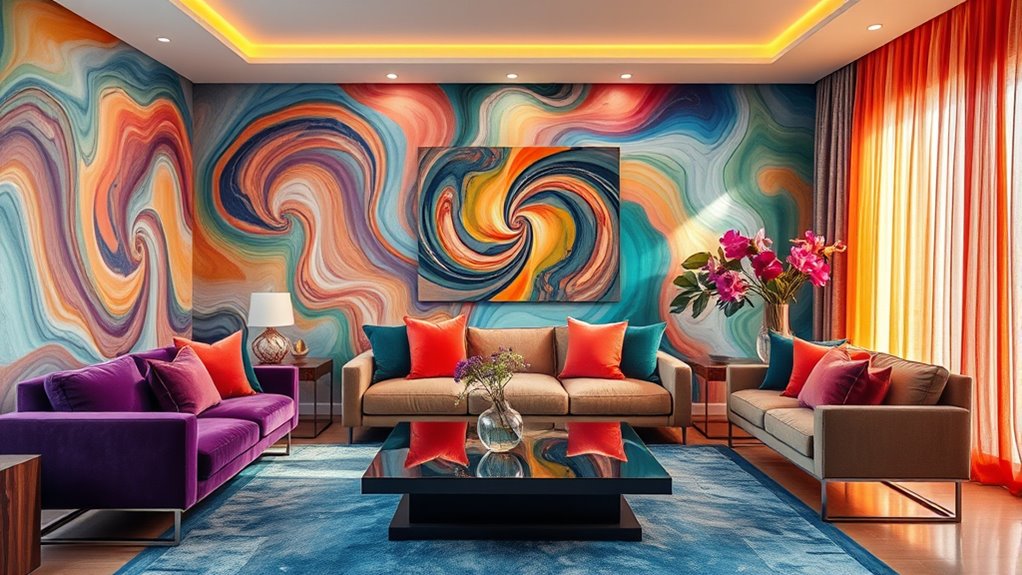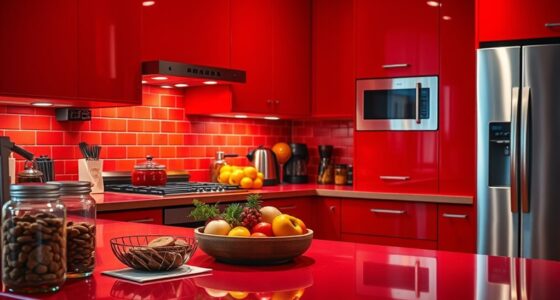Synesthetic décor involves creating spaces that combine visual, auditory, tactile, and olfactory cues to evoke vibrant, multisensory experiences. You can do this by pairing colors with sounds, textures with smells, and lighting with tastes, crafting harmonious environments that stimulate multiple senses simultaneously. This approach makes spaces feel more alive and emotionally engaging. If you keep exploring, you’ll discover how to design environments that truly resonate on every sensory level.
Key Takeaways
- Incorporate multisensory elements like lighting, sound, and textures that evoke specific colors and emotions simultaneously.
- Use ambient sounds paired with visual cues to create a synesthetic experience where sound visually “colors” the environment.
- Curate sensory inputs that connect across senses, such as textures matching color themes or scents complementing visual palettes.
- Balance sensory stimuli thoughtfully to ensure they harmonize, enhancing the feeling of a cohesive, colorful “sound” landscape.
- Design environments that encourage full sensory engagement, transforming spaces into vibrant, memorable, and emotionally resonant experiences.

Have you ever experienced a space that seems to evoke multiple senses at once? If so, you’ve encountered a form of sensory integration in action. It’s a phenomenon that artists, designers, and architects harness through multisensory design—creating environments that engage more than just your sight. When done well, these spaces don’t simply look beautiful; they feel alive, resonating on different sensory levels simultaneously.
In synesthetic décor, the goal is to craft environments where sounds might evoke colors, textures imply tastes, or lighting suggests specific smells. This approach taps into multisensory design principles, blending visual elements with textures, sounds, and even scents to produce a cohesive sensory experience. Think of walking into a room where the soft hum of ambient music triggers a sense of warmth, or where the cool touch of smooth surfaces aligns with the calming shades of blue. Such environments allow your senses to work together rather than in isolation, heightening emotional responses and creating memorable impressions.
To achieve this, you focus on carefully curating each sensory input. Bright, vibrant colors can be paired with textured fabrics that invite touch, reinforcing the visual message through tactile feedback. Soft, diffused lighting may complement gentle sounds or subtle fragrances, making the space feel harmonious. By thoughtfully integrating these elements, you create an immersive environment that encourages your brain to connect dots across senses. It’s about designing spaces that do more than look good—they feel good, sound good, and sometimes even smell good, all at once.
Creating a balanced environment also involves understanding the importance of mindfulness, which can help you tune into sensory details and enhance your experience. The challenge lies in balancing these elements so they complement rather than compete. Sensory integration requires precision: too much stimulation can overwhelm, while too little might fail to engage. Multisensory design is about finding that sweet spot where each sense enriches the others, leading to a richer, more textured experience. You want your space to not only look inviting but to evoke specific feelings or memories through the interplay of senses. When successful, it transforms ordinary spaces into vibrant, dynamic environments that stimulate your mind and body simultaneously.
Ultimately, synesthetic décor is an art of harmony—crafting environments where your senses collaborate beautifully rather than compete. It encourages you to engage fully, experiencing a space with an openness that goes beyond sight alone. By leveraging sensory integration and multisensory design, you can turn any environment into an enthralling, multi-layered experience that leaves a lasting impression on everyone who enters.
Frequently Asked Questions
How Can I Incorporate Synesthetic Elements Into Small Spaces?
To incorporate synesthetic elements into small spaces, you should focus on creating multisensory layouts that activate multiple senses at once. Use sensory art like textured wall hangings or colorful lighting to add visual and tactile interest. Incorporate scent diffusers or soft background music to engage smell and sound. Keep it simple and balanced, layering these elements thoughtfully so your space feels vibrant without being overwhelming.
What Materials Best Evoke Synesthetic Experiences in Décor?
When choosing materials to evoke synesthetic experiences, focus on texture contrast and tactile materials. You might select rough and smooth surfaces together, like a velvet cushion next to a ceramic vase, to stimulate your senses. Incorporate varied textures such as soft fabrics, glossy finishes, or textured wall coverings. These tactile materials create a multisensory environment that engages both sight and touch, making your space feel more vibrant and immersive.
Are There Specific Color Schemes That Enhance Synesthetic Perception?
Did you know that certain color schemes can boost multisensory harmony and chromatic resonance? To enhance synesthetic perception, opt for vibrant, contrasting colors like deep blues and bright yellows, which stimulate multiple senses simultaneously. Cool tones paired with warm hues create dynamic visual and auditory experiences, helping you craft spaces that feel more alive and interconnected. Your choice of color schemes can truly transform environments into immersive, multisensory havens.
How Do Different Lighting Conditions Affect Synesthetic Décor?
Different lighting ambiance profoundly impacts sensory integration in your space. Bright, natural light can enhance color vibrancy, making visual and auditory sensations more vivid, while dim or warm lighting creates a cozy atmosphere that may mellow sound and color perceptions. Adjusting lighting conditions helps you tailor the sensory experience, amplifying or softening the synesthetic effects, and ensuring your décor stimulates your senses just the way you want.
Can Synesthetic Décor Influence Mood and Productivity?
Imagine your space as a symphony where colors and sounds blend through multisensory integration. Synesthetic décor taps into emotional resonance, influencing your mood and productivity. When you surround yourself with harmonious, vibrant elements, you create an environment that energizes and calms simultaneously. This intentional design leverages sensory interplay, boosting focus and uplifting your spirits, proving that well-crafted multisensory spaces can truly shape your emotional and functional well-being.
Conclusion
Imagine walking into a space where colors dance to the rhythm of sound, and every texture sings. By embracing synesthetic décor, you don’t just decorate—you create an immersive experience that appeals to all your senses. Isn’t it fascinating how design can transcend sight and sound, blending them into a vibrant symphony? So, why settle for ordinary when your space can become a colorful, harmonious masterpiece that truly awakens your senses?









